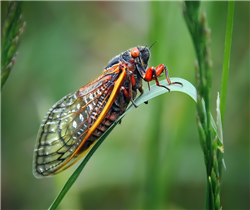 Purdue University - Extension - Forestry and Natural Resources
Purdue University - Extension - Forestry and Natural Resources
Got Nature? Blog
 For first time in 221 years, two cicada broods to emerge in Indiana simultaneously, The Indianapolis Star: Cicadas are buzzing back to Indiana in 2024, and in a big way say bug experts.
For first time in 221 years, two cicada broods to emerge in Indiana simultaneously, The Indianapolis Star: Cicadas are buzzing back to Indiana in 2024, and in a big way say bug experts.
For the first time in 221 years, two different broods of cicadas — the 17-year Brood XIII and the 13-year Brood XIX — will appear in parts of Indiana and other states. A dual emergence is rare, according to Dr. Gene Kritsky of Cincinnati’s Mount St. Joseph University.
The last time two broods of cicadas emerged at once in Indiana, the year was 1803 and Thomas Jefferson was President. Different broods of cicadas have popped up in other states, however, such as Missouri in 1998, or when rock album “Windows from Heaven” was released by Jefferson Starship.
Here’s what we know about this unique, natural event happening in Indiana and large swaths of the Midwest.
How often do cicadas appear in Indiana?
While annual cicadas appear every 2-5 years, broods of periodical cicadas will emerge once every 17 years across the Hoosier state. There are two broods, however, that emerge every 13 years, according to Purdue University.
These black-bodied, red-eyed, winged insects crawl out of the ground from around late May to June to reproduce and begin their life-cycle anew. Cicadas can be found on every continent except Antarctica. There are more than 3,000 different species of cicadas around the world, according to the Indiana Department of Natural Resources.
Brood XIII (17-year brood) cicadas are coming to the Midwest in 2024
Brood XIII cicadas will emerge in parts of Indiana, Iowa, Wisconsin and possibly Michigan, according to CicadaMania.org, but are expected to be concentrated in Illinois. These cicadas last emerged in 2007.
This year, cicadas in Illinois will create some unique challenges for entomologists, according to the University of Connecticut. The Prairie State is home to both the 17- and 13-year cicada broods.
Where will Brood XIII cicadas appear in Indiana in 2024?
In 2024, Brood XIII cicadas will appear in areas of Lake, LaPorte, and Porter counties in the upper northwestern side of Indiana, according to Purdue University.
Do cicadas bite?
Cicadas might look scary with their red eyes, huge wings and prickly feet, but they’re harmless to humans.
They don’t sting or carry diseases, and they don’t bite. In fact, cicadas don’t have mouth parts that can bite, said Elizabeth Barnes, an entomologist with Purdue University in a previous article by IndyStar.
No, they won’t bite: Debunking 8 common myths about cicadas
What about the other species of cicadas? Where will Brood XIX (13-year brood) cicadas appear?
This year the Brood XIX cicadas are set to emerge in 15 states across the country. They’ll appear in Alabama, Arkansas, Georgia, Illinois, Indiana, Kentucky, Louisiana, Missouri, Mississippi, North Carolina, Oklahoma, South Carolina and Virginia.
Where will Brood XIX cicadas appear in Indiana in 2024?
In 2024, the 13-year Brood XIX cicadas will appear in 8 western counties across the Hoosier State, according to Purdue University, from Posey and Warrick counties near Evansville in the south, to Newton and Jasper counties on the north.
To see the full story and video please visit the IndyStar.
Resources:
Periodical Cicadas, Indiana Department of Natural Resources, Division of Entomology
Billions of Cicadas Are Coming This Spring; What Does That Mean for Wildlife?, Got Nature? Blog, Purdue Extension-Forestry and Natural Resources (FNR)
17 Ways to Make the Most of the 17-year Cicada Emergence, Purdue College of Agriculture
Ask an Expert: Cicada Emergence Video, Got Nature? Blog, Purdue Extension-FNR
Periodical Cicada in Indiana, The Education Store, Purdue Extension resource center
Cicada Killers, The Education Store
Purdue Cicada Tracker, Purdue Extension-Master Gardener Program
Cicada, Youth and Entomology, Purdue Extension
Indiana Department of Entomology and Plant Pathology
Tim Gibb, Insect Diagnostician and Extension Specialist
Purdue Department of Entomology

Recent Posts
- Report Spotted Lanternfly – Purdue Landscape Report
Posted: April 10, 2024 in Alert, Forestry, Invasive Insects, Plants, Wildlife, Woodlands - Declining Pines of the White Variety – Purdue Landscape Report
Posted: in Alert, Disease, Forestry, Plants, Wildlife, Woodlands - Are you seeing nests of our state endangered swan? – Wild Bulletin
Posted: April 9, 2024 in Alert, Forestry, How To, Wildlife - Cicadas in Spring! – Purdue Landscape Report
Posted: in Forestry, Plants, Safety, Wildlife - New Deer Impact Toolbox
Posted: April 7, 2024 in Forestry, Land Use, Plants, Publication, Safety, Wildlife, Woodlands - 2024-25 Fishing Guide now available – Wild Bulletin
Posted: April 4, 2024 in Alert, Aquaculture/Fish, Aquatic/Aquaculture Resources, How To, Ponds, Wildlife - Help Research Chronic Wasting Disease – Wild Bulletin
Posted: April 3, 2024 in Disease, Forestry, How To, Safety, Wildlife, Woodlands - Indiana Reptiles and Amphibians – IFWOA Webinar
Posted: April 1, 2024 in Forestry, How To, Webinar, Wildlife, Woodlands - Birding through the Seasons – IFWOA Webinar
Posted: in Forestry, How To, Webinar, Wildlife, Woodlands - Look Out for Invasive Carp in Your Bait Bucket – Wild Bulletin
Posted: March 31, 2024 in Alert, Aquaculture/Fish, Aquatic/Aquaculture Resources, Invasive Animal Species, Wildlife
Archives
Categories
- Alert
- Aquaculture/Fish
- Aquatic/Aquaculture Resources
- Ask the Expert
- Christmas Trees
- Community Development
- Disease
- Drought
- Forestry
- Forests and Street Trees
- Gardening
- Got Nature for Kids
- Great Lakes
- How To
- Invasive Animal Species
- Invasive Insects
- Invasive Plant Species
- Land Use
- Natural Resource Planning
- Nature of Teaching
- Plants
- Podcasts
- Ponds
- Publication
- Safety
- Timber Marketing
- Uncategorized
- Urban Forestry
- Webinar
- Wildlife
- Wood Products/Manufacturing
- Woodland Management Moment
- Woodlands